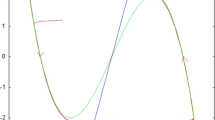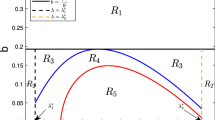Abstract
The paper deals with the issue of self-organization in applied sciences. It is particularly related to the emergence of Turing patterns. The goal is to analyze the domain size driven instability: We introduce the parameter L, which scales the size of the domain. We investigate a particular reaction-diffusion model in 1-D for two species. We consider and analyze the steady-state solution. We want to compute the solution branches by numerical continuation. The model in question has certain symmetries. We define and classify them. Our goal is to calculate a global bifurcation diagram.
Similar content being viewed by others
References
E. L. Allgower, K. Georg: Introduction to Numerical Continuation Methods. Classics in Applied Mathematics 45. SIAM, Philadelphia, 2003.
R. E. Baker, E. A. Gaffney, P. K. Maini: Partial differential equations for self-organization in cellular and developmental biology. Nonlinearity 21 (2008), R251–R290.
K. Böhmer, W. Govaerts, V. Janovský: Numerical detection of symmetry breaking bifurcation points with nonlinear degeneracies. Math. Comput. 68 (1999), 1097–1108.
P. Chossat, R. Lauterbach: Methods in Equivariant Bifurcations and Dynamical Systems. Advanced Series in Nonlinear Dynamics 15. World Scientific, Singapore, 2000.
A. Dhooge, W. Govaerts, Y. A. Kuznetsov: MATCONT: A MATLAB package for numerical bifurcation analysis of ODEs. ACM Trans. Math. Softw. 29 (2003), 141–164.
A. Dhooge, W. Govaerts, Y. A. Kuznetsov: MATCONT and CL-MATCONT: Continuation Toolboxes in MATLAB. University Gent, Gent, 2011.
A. Gierer, H. Meinhardt: A theory of biological pattern formation. Kybernetik 12 (1972), 30–39.
M. Golubitsky, D. G. Schaeffer: Singularities and Groups in Bifurcation Theory. I. Applied Mathematical Sciences 51. Springer, New York, 1985.
M. Golubitsky, I. Stewart, D. G. Schaeffer: Singularities and Groups in Bifurcation Theory. II. Applied Mathematical Sciences 69. Springer, New York, 1988.
W. J. F. Govaerts: Numerical Methods for Bifurcations of Dynamical Equilibria. SIAM, Philadelphia, 2000.
V. Janovský, P. Plecháč: Numerical applications of equivariant reduction techniques. Bifurcation and Symmetry: Cross Influence Between Mathematics and Applications. International Series of Numerical Mathematics 104. Birkhäuser, Basel, 1992, pp. 203–213.
V. Klika: Significance of non-normality-induced patterns: Transient growth versus asymptotic stability. Chaos 27 (2017), Article ID 073120, 9 pages.
V. Klika, R. E. Baker, D. Headon, E. A. Gaffney: The influence of receptor-mediated interactions on reaction-diffusion mechanisms of cellular self-organisation. Bull. Math. Biol. 74 (2012), 935–957.
V. Klika, M. Kozák, E. A. Gaffney: Domain size driven instability: Self-organization in systems with advection. SIAM J. Appl. Math. 78 (2018), 2298–2322.
Y. A. Kuznetsov: Elements of Applied Bifurcation Theory. Applied Mathematical Sciences 112. Springer, New York, 1998.
A. Marciniak-Czochra, G. Karch, K. Suzuki: Instability of Turing patterns in reaction-diffusion-ODE systems. J. Math. Biol. 74 (2017), 583–618.
J. D. Murray: Mathematical Biology. II. Spatial Models and Biomedical Applications. Interdisciplinary Applied Mathematics 18. Springer, New York, 2003.
J. Schnakenberg: Simple chemical reaction systems with limit cycle behaviour. J. Theoret. Biol. 81 (1979), 389–400.
L. N. Trefethen, M. Embree: Spectra and Pseudospectra. The Behavior of Nonnormal Matrices and Operators. Princeton University Press, Princeton, 2005.
A. M. Turing: The chemical basis of morphogenesis. Philos. Trans. R. Soc. Lond., Ser. B, Biol. Sci. 237 (1952), 37–72.
Author information
Authors and Affiliations
Corresponding author
Rights and permissions
About this article
Cite this article
Janovský, V. Analysis of pattern formation using numerical continuation. Appl Math 67, 705–726 (2022). https://doi.org/10.21136/AM.2022.0126-21
Received:
Published:
Issue Date:
DOI: https://doi.org/10.21136/AM.2022.0126-21




